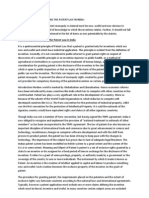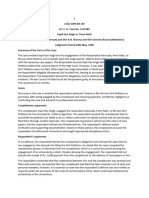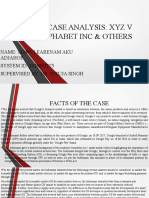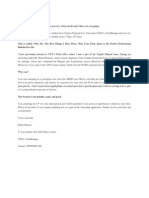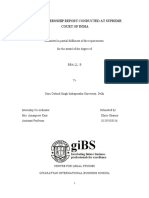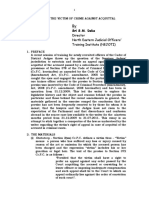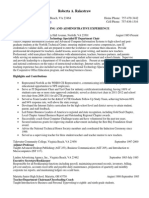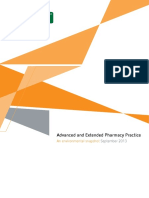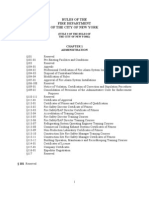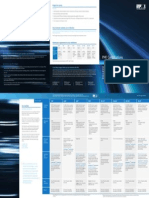Cases On Ipr
Cases On Ipr
Uploaded by
ShreekzCopyright:
Available Formats
Cases On Ipr
Cases On Ipr
Uploaded by
ShreekzOriginal Description:
Original Title
Copyright
Available Formats
Share this document
Did you find this document useful?
Is this content inappropriate?
Copyright:
Available Formats
Cases On Ipr
Cases On Ipr
Uploaded by
ShreekzCopyright:
Available Formats
CASES
TRADEMARK
TRADEMARK
Emperor v. Dahyabhai Chakasha
The National Bank of India used to import bars of gold for sale in
India.
Each bar was of a uniform size, weight and purity and had the
words "National Bank of India" inscribed on it as its property
mark.
The gold so imported was known in the market as 'Nasrana Bak',
and acquired a special value in the market. The accused placed in
the market gold of their own mark with words 'Nasrana Bak'
inscribed on their bars. The High Court of Bombay held that the
National Bank of India owned a property mark in the bars
imported by it, and that the accused were guilty of counterfeiting
that property mark. It further held that though some of these
bars had been sold by the Bank and had thus passed out of its
hands, that that fact did not mean that its property mark did not
remain, for, the function of a property mark to denote ownership
is not destroyed because any part of it on which it was impressed
has ceased to be of that ownership.
Satyam Infoway Ltd. v. Sifynet Solutions Pvt. Ltd.
Satyam Infoway Ltd., alleged that the Sifynet Solutions Pvt. Ltd., had
intentionally registered and operated a domain name that was confusingly
similar to one owned by Satyam Infoway. Satyam Infoway claimed that it
had in 1999, registered several domain names pertaining to its business:
sifynet.com, sifymall.com, sifyrealestate.com, with the Internet Corporation
for Assigned Names and Numbers (ICANN) and the World Intellectual
Property Organization (WIPO).
Meanwhile, Sifynet Solutions had started using the word "Siffy" as part of
the domain names under which it carried on internet marketing (namely
siffynet.com and siffynet.net), claiming to have registered them with ICANN
in 2001.
The Supreme Court ddeclared that domain names are subject to the
regulatory framework that is applied to trade marks (i.e. the Trade Marks
Act, 1999).
The court stated that though there is no law in India which explicitly governs
the regime of domain names, this state of affairs does not foreclose
protection for domain names under the aegis of the Trade Marks Act. Thus,
the court determined that domain names are protected under the law
relating to passing off as delineated in the Trade Marks Act
Geep Flashlight Ind. v. Registrar of Trade Marks
AIR 1972 Delhi 179
Jeep Industries filed for registration of the trade mark consisting
essentially of the word 'Janta' in respect of electric torches.
Assistant Registrar of copyright declined to register the appellant's trade
mark mainly on the ground that it was not either distinctive or capable
of distinguishing.
the word 'Janta' was phonetically similar to the word 'Janta' which was
word of common use and which was neither distinctive nor capable of
distinguishing the goods of the appellant.
Appellant contended that the word 'Janta' is quite distinct from the word
'Janta' and that in Hindi the word 'Janta' meant knowledge and that it
was in that sense that the word was used in the appellant's proposed
trade mark.
Delhi HC held that although the appellant had led evidence to prove that
its torches bearing the name 'Janta' have acquired considerable
reputation in the market, still the word 'Janta' is in fact not adapted to
distinguish or is in fact not capable of distinguishing the appellant's
goods.
Hindustan Development Corporation Ltd. Vs. The
Deputy Registrar of Trade Marks and Anr
Issue
Whether the word 'Rasoi', if and when used as a trade mark for
the hydrogenated ground-nut oil manufactured by the appellant
company, has a direct reference to the character or quality of the
goods, within the meaning of Section 6(1)(d), Trade Marks Act,
1940 and is, as such, outside the ambit of that clause.
Held
the word 'Rasoi' nevertheless be ineligible for registration in view
of the fact that it is a common word of the language of which no
monopoly should be granted to a particular trader. It is
undoubtedly true that the common words, of a language are
public property and that no one should be allowed to appropriate
one of such words to his exclusive use and thereby deprive other
persons of the legitimate right to use the said word.
Eastman Photographic Materials Company v Comptroller-
General of Patents, Designs, and Trade-marks
[1898] AC 571
appellants having applied to the Comptroller of Patents,
Designs, and Trade-Marks to register " Solio " as a trade-
mark in
Class 39 in respect of photographic paper.
It was refused by comptroller and lower courts on the
ground by that " Solio " suggested " Sol, " the sun, and
therefore had " reference to the character or quality of
the goods "
House of Lords held that it was registable being an
invented word.
Eastman Photographic Materials Company v Comptroller-
General of Patents, Designs, and Trade-marks
[1898] AC 571
Bailey v. Clark (1938) 55 RPC
253)
Bailey v. Clark
Respondent obtained registration in United
Kingdom with regard to GLASTONBURY
for sheepskin slippers .
Glastonbury was a place famous for leather
manufacturing.
Set aside on the reasoning that it will be
harmful for all other manufacturers in the
future.
Pepsi-Cola Company of Canada, Ltd v. The
Coca-Cola Company of Canada, Ltd.
Question of the similar part of their names.
Plaintiff had not established a claim for
infringement from defendant's use of the trade
mark "Pepsi-Cola." In the general attitude taken
by plaintiff, its objection really went to the
registration by any other person of the word
"cola" in any combination, for a soft drink; and if
such objection were allowed, then plaintiff would
virtually become the possessor of an exclusive
proprietary right in relation to the word "cola";
and to this it was not entitled.
Cadila Healthcare Limited vs Cadila
Pharmaceuticals Limited (2001) 5 SCC 73
The suit related to a medicine being sold under
the brand name Falcitab by the respondent
which, according to the appellant, was a brand
name similar to the drug being sold by it under
its brand name Falcigo.
On 7th October, 1996 the Drugs Controller
General (India) granted permission to the
appellant to market the said drug under the
trade mark of Falcigo. It is, thereafter, that since
October, 1996 the appellant claimed to have
started the manufacture and sale of drug Falcigo
all over India.
Cadila Healthcare Limited vs Cadila
Pharmaceuticals Limited
Respondent company is stated to have got
permission on 10th April, 1997 to
manufacture a drug containing Mefloquine
Hydrochloride, being sold by the respondent
under the trade mark of Falcitab.
the High Court came to the conclusion that it
could not be said that there was a likelihood
of confusion being caused to an unwary
consumer in respect of the disputed marks.
Cadila Healthcare Limited vs Cadila
Pharmaceuticals Limited
Held
The appellants are right in contending that where medicinal products
are involved, the test to be applied for adjudging the violation of trade
mark law may not be at par with cases involving non-medicinal
products.
Public interest would support lesser degree of proof showing confusing
similarity in the case of trade mark in respect of medicinal product as
against other non-medicinal products. Drugs are poisons, not sweets.
Confusion between medicinal products may, therefore, be life
threatening, not merely inconvenient.
A stricter approach should be adopted while applying the test to judge
the possibility of confusion of one medicinal product for another by the
consumer. While confusion in the case of non-medicinal products may
only cause economic loss to the plaintiff, confusion between the two
medicinal products may have disastrous effects on health and in some
cases life itself.
COLLECTIVE MARK
A collective trademark, collective trade
mark, or collective mark is a trademark
owned by an organization (such as an
association), used by its members them to
identify themselves with a level of quality or
accuracy, geographical origin, or other
characteristics set by the organization.
Collective Mark
A collective trademark, however, can be used by a
variety of traders, rather than just one individual
concern, provided that the trader belongs to the
association.
The members of the association are bound by
regulations governing use of the collective mark.
A collective mark is registrable under the Act.
The regulations governing use of the mark are
required to be filed with the application.
If the Registrar is satisfied with the terms, then it is
published in the Trademarks Journal and follows the
same procedure as other applications.
Certification Trademark
A certification mark is a type of trademark whereby a
trader uses the mark to indicate the origin, material,
mode of manufacture of products, mode of performance
of services, quality, accuracy of other characteristics of
products or services.
They are generally used by industrial standards bodies or
certification companies to demonstrate that a product or
service meets a certain standard.
Collective v. Certification
collective trademarks may be used by
particular members of the organization
which owns them
certification marks may be used by
anybody who complies with the standards
defined by the owner of the particular
certification mark.
For a mark to qualify to be registered as a
collective mark,
1. the applicant must be an association of
persons and the application must be
accompanied by the regulation
governing use of such marks.
2. The object of the association, the
conditions of membership and
relationship of each member as well as
the sanction against the misuse are
some of the pre-requisites required to
be specified for registration of a
collective mark.
3. The certification mark, can be
registered only in the name of a person
who does not carry on the trade in the
goods of the kind certified or a trade of
the provisions of services of the kind
certified.
For a mark to qualify to be registered as a
Certification Mark, the applicant must
specify
1. The nature of the Applicant's business;
2. Particulars of infrastructure like R&D,
technical manpower support;
3. Applicants' competence to administer
the certification scheme;
4. An undertaking from the Applicant that
there will be no discrimination against
anyone;
5. The people authorized to use the
certification mark
6. The characteristics to be certified by the
certification mark
CASES
PATENT
Diamond v. Chakrabarty, 447 U.S.
303 (1980)
Genetic engineer Ananda Mohan
Chakrabarty, working for General Electric,
had developed a bacterium (known as
Pseudomonas putida) capable of breaking
down crude oil, which he proposed to use in
treating oil spills.
Diamond v. Chakrabarty, 447 U.S.
303 (1980)
General Electric filed a patent application for
the bacterium in the United States listing
Chakrabarty as the inventor, but the
application was rejected by a patent
examiner, because under patent law at that
time it was generally understood that living
things were not patentable subject matter
under Section 101 of Title 35 U.S.C.
US SUPREME COURT VERDICT
In a 54 ruling, the court ruled in favor of
Chakrabarty, holding that:
A live, human-made micro-organism is
patentable subject matter under 35 U.S.C. 101.
Respondent's micro-organism constitutes a
"manufacture" or "composition of matter" within
that statute.
Glivec Patent Case (Novartis AG v. Union of
India & Others) (2013) 6 SCC 1
The patent application claimed the final form of
Gleevec (the beta crystalline form of imatinib
mesylate).
Novartis set the price of Gleevec at USD 2666 per
patient per month; generic companies were selling
their versions at USD 177 to 266 per patient per
month.
When examination of Novartis' patent application
began in 2005, it came under immediate attack from
oppositions initiated by generic companies that
were already selling Gleevec in India and by
advocacy groups. The application was rejected by
the patent office and by an appeal board.
Novartis v. Union of India
Novartis v. Union of India
The key basis for the rejection was the part of
Indian patent law that was created by
amendment in 2005, describing the
patentability of new uses for known drugs
and modifications of known drugs. That
section, Paragraph 3d, specified that such
inventions are patentable only if "they differ
significantly in properties with regard to
efficacy."
Novartis v. Union of India
The Supreme Court decided that the substance
that Novartis sought to patent was indeed a
modification of a known drug (the raw form of
imatinib, which was publicly disclosed in the
1993 patent application and in scientific articles),
that Novartis did not present evidence of a
difference in therapeutic efficacy between the
final form of Gleevec and the raw form of
imatinib, and that therefore the patent
application was properly rejected by the patent
office and lower courts.
Natco v. Beyer
Nexavar owned by Bayer Corporation
Sorafenib (co-developed and co-marketed by Bayer
and Onyx Pharmaceuticals as Nexavar) is a drug
approved for the treatment of primary kidney cancer
(advanced renal cell carcinoma), advanced primary
liver cancer (hepatocellular carcinoma), and
radioactive iodine resistant advanced thyroid
carcinoma.
Rs. 2,84,428 is the cost of Naxavar sold by Bayer.
Hyderabad based NATCO Pharma Limited filed a
compulsory license to sell it for Rs. 8880/- for a pack
of 120 tablets
Natco v. Beyer
The Intellectual Property Appellate Board (IPAB)
on Monday upheld the grant of compulsory
licence (CL) to Natco Pharma, to produce and
market Nexavar.
As per the licence conditions imposed by
Controller, Natco had to pay a six per cent
royalty to Bayer from the sales of generic drug
Nexavar. Modifying this, the IPAB directed Natco
to pay seven percent royalty.
Going into various submissions and affidavits
filed by Bayer, the Board also came to conclusion
that its pricing of Rs.2.8 lakh was not affordable.
Natco v. Beyer
CIPLAS ATTACK
Cipla had launched its generic version of
Nexavar before Natco won the compulsory
licence. Cipla undercut Natcos price in May
last year and now sells the drug at Rs.6,840
for a months dose.
GATT
The General Agreement on Tariffs and Trade (GATT)
was a multilateral agreement regulating international
trade.
GATT was signed in 1947 and lasted until 1994, when it
was replaced by the World Trade Organization in 1995.
According to its preamble, its purpose was the
"substantial reduction of tariffs and other trade barriers
and the elimination of preferences, on a reciprocal and
mutually advantageous basis.
Whilst GATT was a set of rules agreed upon by nations,
the WTO is an institutional body.
You might also like
- Iso Iec 17026-2015Document38 pagesIso Iec 17026-2015El100% (2)
- Counter StatementDocument12 pagesCounter Statementutkarshlegal96No ratings yet
- Lotus Regalia Opposition ReplyDocument18 pagesLotus Regalia Opposition ReplymuskanNo ratings yet
- Counter Statement Plus Objection ReplyDocument6 pagesCounter Statement Plus Objection ReplyJaya Vats100% (1)
- Assignment - 3 (Prior User of A Trademark Will Override The Subsequent User Even If The Subsequent User Has Registered The Trademark)Document6 pagesAssignment - 3 (Prior User of A Trademark Will Override The Subsequent User Even If The Subsequent User Has Registered The Trademark)Dhruv MalikNo ratings yet
- Free Ebook Before Memory Fades An AutobiographyDocument2 pagesFree Ebook Before Memory Fades An AutobiographyAmar0% (1)
- FIRST AID BEAUTY FAB - Counter StatementDocument9 pagesFIRST AID BEAUTY FAB - Counter StatementWorkaholic100% (1)
- ER Reply DraftDocument5 pagesER Reply DraftAnanya PandeNo ratings yet
- Section 9 of Trademarks ActDocument8 pagesSection 9 of Trademarks Actjayesh kimar singhNo ratings yet
- Cases On 9 (1) (A)Document2 pagesCases On 9 (1) (A)Dakshita Dubey100% (2)
- Professional Ethics Tutorial-1 Case Analysis D. P Chaddha v. Triyugi Narayan Mishra AIR 2001 SC 457Document9 pagesProfessional Ethics Tutorial-1 Case Analysis D. P Chaddha v. Triyugi Narayan Mishra AIR 2001 SC 457MadhuritaNo ratings yet
- Training Services Website PDF Guide PDFDocument19 pagesTraining Services Website PDF Guide PDFSukhjinder SinghNo ratings yet
- What Is A Slot TechnicianDocument4 pagesWhat Is A Slot TechnicianChalez ZengeretsiNo ratings yet
- Infringement:: Differences Between Passing Off and InfringementDocument3 pagesInfringement:: Differences Between Passing Off and InfringementMukesh LalNo ratings yet
- Trademark CasesDocument12 pagesTrademark CasesThomas JosephNo ratings yet
- A Simple Guide for Drafting of Conveyances in India : Forms of Conveyances and Instruments executed in the Indian sub-continent along with Notes and TipsFrom EverandA Simple Guide for Drafting of Conveyances in India : Forms of Conveyances and Instruments executed in the Indian sub-continent along with Notes and TipsNo ratings yet
- Registration, Assignment and Transmission of Trade Marks and Domain NamesDocument48 pagesRegistration, Assignment and Transmission of Trade Marks and Domain NamesRobin SinghNo ratings yet
- IBC Notes by Y&A Legal PDFDocument87 pagesIBC Notes by Y&A Legal PDFbhio100% (1)
- Law of E-Commerce Unit 5Document24 pagesLaw of E-Commerce Unit 5Dhruvo DasNo ratings yet
- A Critical Analysis of The Trade Mark Law in India With Special Reference To The Passing OffDocument21 pagesA Critical Analysis of The Trade Mark Law in India With Special Reference To The Passing Offalam amarNo ratings yet
- Reply To Trademark ObjectionDocument2 pagesReply To Trademark ObjectionKajal ChanchalaniNo ratings yet
- Affidavit Under Rule 45Document14 pagesAffidavit Under Rule 45Harsh kushwaha100% (1)
- Aishwarya Chevuturi (Resume)Document3 pagesAishwarya Chevuturi (Resume)chitra lounganiNo ratings yet
- Achal Saxena and Anr. V. Sudhir YadavDocument22 pagesAchal Saxena and Anr. V. Sudhir YadavNiharika BhatiNo ratings yet
- Infringement of Registered Trademarks, Offences Relating To Trade Mark and Passing OffDocument28 pagesInfringement of Registered Trademarks, Offences Relating To Trade Mark and Passing OffArunaMLNo ratings yet
- Basic Principles Underlying The Patent Law in IndiaDocument5 pagesBasic Principles Underlying The Patent Law in IndiaSmitha Kollerahithlu67% (3)
- Anil Gupta vs. Kunal Das GuptaDocument5 pagesAnil Gupta vs. Kunal Das GuptaAlo DuttNo ratings yet
- Case Analysis of Satyam Infoways CaseDocument4 pagesCase Analysis of Satyam Infoways CaseKanhaiya SinghalNo ratings yet
- IN THE Matter OF THE Trademarks Act, 1999Document9 pagesIN THE Matter OF THE Trademarks Act, 1999Kajal ChanchalaniNo ratings yet
- The Legislature Does Not Commit Mistakes or Make OmissionsDocument1 pageThe Legislature Does Not Commit Mistakes or Make Omissionskabir kapoorNo ratings yet
- M S Mankind Pharma LTD Vs M S Neospark Drugs Chemicals On 21 March 2015Document9 pagesM S Mankind Pharma LTD Vs M S Neospark Drugs Chemicals On 21 March 2015tanyaNo ratings yet
- Design CasesDocument9 pagesDesign CaseskratiNo ratings yet
- Case Analysis-50Document12 pagesCase Analysis-50Nanditha SwamyNo ratings yet
- Registration of Trademarks PDFDocument23 pagesRegistration of Trademarks PDFSiva Ganga SivaNo ratings yet
- Case Study - Maninderjeet Singh Bitta v. UOI, (2011) 11 SCALE 634Document3 pagesCase Study - Maninderjeet Singh Bitta v. UOI, (2011) 11 SCALE 634Shriya SehgalNo ratings yet
- IPR-Trademark Case Laws - CompendiumDocument11 pagesIPR-Trademark Case Laws - CompendiumShamilee RajkumarNo ratings yet
- Form TM-O UploadDocument7 pagesForm TM-O UploadsahajNo ratings yet
- Physical Research Laboratory vs. K.G. Sharma (1997) 4 SCC 257Document1 pagePhysical Research Laboratory vs. K.G. Sharma (1997) 4 SCC 257Nikhil GuptaNo ratings yet
- CASE ANALYSIS Xyz V Alphabet IncDocument11 pagesCASE ANALYSIS Xyz V Alphabet IncJohnson BrisbaneNo ratings yet
- Nirma Industries CaseDocument6 pagesNirma Industries CaseSubh Ashish0% (1)
- Summer Internship ReportDocument41 pagesSummer Internship ReportPrisha BansalNo ratings yet
- Case Summary Copyrights 7 16Document130 pagesCase Summary Copyrights 7 16Chintakayala SaikrishnaNo ratings yet
- Enrolment FormDocument11 pagesEnrolment FormParvathy KumarNo ratings yet
- Shri Shamsher Kataria VDocument13 pagesShri Shamsher Kataria VAishwarya SudhirNo ratings yet
- Trademarks InfringementDocument41 pagesTrademarks Infringementshriya varmaNo ratings yet
- Sakarlal NaranlalDocument8 pagesSakarlal Naranlalsonakshi182No ratings yet
- Cover Letter For InternshipDocument1 pageCover Letter For Internshipmanish88raiNo ratings yet
- A Bird's Eye View of Rightsand Privileges of Lawyers in IndiaDocument11 pagesA Bird's Eye View of Rightsand Privileges of Lawyers in IndiaAbhishek Kumar100% (1)
- Case Study of PVR and DT Cinema CombinationDocument3 pagesCase Study of PVR and DT Cinema CombinationRajdeep SinghNo ratings yet
- Sony Corporation vs. K. SelvamurthyDocument2 pagesSony Corporation vs. K. SelvamurthyAnagha ShelkeNo ratings yet
- Anees Ahmed VsDocument2 pagesAnees Ahmed VsrohanNo ratings yet
- IRACDocument30 pagesIRACira singhalNo ratings yet
- The Madras Refineries Ltd. v. The Chief Controlling Revenue AuthorityDocument2 pagesThe Madras Refineries Ltd. v. The Chief Controlling Revenue Authoritygparth247No ratings yet
- D.P.Chadha v. Triyugi Narain MishraDocument21 pagesD.P.Chadha v. Triyugi Narain Mishrasanjana sethNo ratings yet
- Assignment & Licensing of Trademarks in IndiaDocument16 pagesAssignment & Licensing of Trademarks in IndiaHarsh Gupta100% (1)
- First Draft of Summer InternshipDocument45 pagesFirst Draft of Summer Internshipdhruv sharmaNo ratings yet
- Professional Ethics Case P D Gupta V Ram Murti & Anr CaseDocument8 pagesProfessional Ethics Case P D Gupta V Ram Murti & Anr Casenavneetsdss1No ratings yet
- Ashok Pandey Vs - Supreme Court of IndiaDocument22 pagesAshok Pandey Vs - Supreme Court of IndiaSoniyam George0% (1)
- Case Note On Shiv Cable V State of RajasthanDocument2 pagesCase Note On Shiv Cable V State of RajasthanShubhank DixitNo ratings yet
- ADR Record FileDocument29 pagesADR Record Filekarishanmu100% (1)
- One Man CompanyDocument14 pagesOne Man CompanyA.VignaeshwarNo ratings yet
- Appeal by Victim Against Acquittal by SM DekaDocument12 pagesAppeal by Victim Against Acquittal by SM DekavishchandraNo ratings yet
- Resume-Rakestraw 2012 - TCCDocument2 pagesResume-Rakestraw 2012 - TCCapi-247852988No ratings yet
- Audit & Cert BodyDocument27 pagesAudit & Cert Bodyshobha shelarNo ratings yet
- People Factors in Cyber Resilience: Creating The Need For Cybersecurity ExpertsDocument22 pagesPeople Factors in Cyber Resilience: Creating The Need For Cybersecurity ExpertsWilfred DsouzaNo ratings yet
- Online Deposit Slip From Designated Bank Branches.: Application FormDocument4 pagesOnline Deposit Slip From Designated Bank Branches.: Application FormViral VidsNo ratings yet
- Human Resource Management in Service SectorDocument3 pagesHuman Resource Management in Service SectorRaj GoswamiNo ratings yet
- Professional (CSCP) Program 2018: Certified Supply ChainDocument14 pagesProfessional (CSCP) Program 2018: Certified Supply ChainfaazalwahabNo ratings yet
- 2018 Prospectus: The Centre For Training & Projects Development (Pty) LTD (CTPD)Document53 pages2018 Prospectus: The Centre For Training & Projects Development (Pty) LTD (CTPD)Jo okNo ratings yet
- Unit1Intro To Laboratory MedicineDocument39 pagesUnit1Intro To Laboratory MedicineleomillmendiolaNo ratings yet
- AWS Certified Welding Inspector (CAWI/CWI/SCWI) : Application For International Agent ExamsDocument4 pagesAWS Certified Welding Inspector (CAWI/CWI/SCWI) : Application For International Agent ExamsMonica CarrollNo ratings yet
- Position (S) Applied: Employment ApplicationDocument4 pagesPosition (S) Applied: Employment ApplicationAnonymous KUR5o6bqZbNo ratings yet
- Model Certificate For Fish and Fishery ProductsDocument6 pagesModel Certificate For Fish and Fishery ProductsJessica FreedNo ratings yet
- Apc0271 V4 PDFDocument53 pagesApc0271 V4 PDFDrAnisha PatelNo ratings yet
- Lead Paint Removal GuidesDocument669 pagesLead Paint Removal GuidesHenryZambrano100% (1)
- Brochure CQE Training NIQR ASQDocument2 pagesBrochure CQE Training NIQR ASQVijayendran VijayNo ratings yet
- Title 3 of The Rules of The FDNYDocument635 pagesTitle 3 of The Rules of The FDNYjouweitoNo ratings yet
- CF Pea PP HandbookDocument51 pagesCF Pea PP HandbookJohn PhyoNo ratings yet
- All You Need To Know About The CIA PDFDocument14 pagesAll You Need To Know About The CIA PDFMohammed OsmanNo ratings yet
- Logistics BrochureDocument4 pagesLogistics Brochurefanmoud2No ratings yet
- Pmi Certifications Brochure 2014Document2 pagesPmi Certifications Brochure 2014sapabapjava2012No ratings yet
- Eacc Jobs AdvertDocument39 pagesEacc Jobs AdvertLuke ShawNo ratings yet
- MU Postgraduate Prospectus 2022Document68 pagesMU Postgraduate Prospectus 2022Martin GohNo ratings yet
- Educational Technology: Definitions and Domains By: Dr. Q. Li Base On (Ely, 2002 AECT, 2000)Document19 pagesEducational Technology: Definitions and Domains By: Dr. Q. Li Base On (Ely, 2002 AECT, 2000)Chan Yi JiaNo ratings yet
- Lisa Holm - ResumeDocument1 pageLisa Holm - Resumeapi-258856736No ratings yet
- RIA - BoR - Architects Chapter - Membership Categorization - 2020Document14 pagesRIA - BoR - Architects Chapter - Membership Categorization - 2020rubarema robertNo ratings yet
- Accounting Professionalization Amidst Alternating State Ideology in EthiopiaDocument28 pagesAccounting Professionalization Amidst Alternating State Ideology in EthiopiatemedebereNo ratings yet
- Aindt0.005 NDTCB Guide June 2013 Issue 18 Rev 2Document33 pagesAindt0.005 NDTCB Guide June 2013 Issue 18 Rev 2Rizwan NazirNo ratings yet
- P-307 December 2009Document342 pagesP-307 December 2009ibgazooNo ratings yet


























